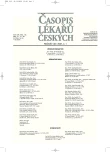A Rare Complication of Acute Lymphoblastic Leukaemia in Young Patients
Authors:
D. Svobodová; J. Slaný; P. Klvaňa 1; B. Blažek; R. Čuřík 2
Authors‘ workplace:
Klinika dětského lékařství FNsP, Ostrava
; Interní klinika FNsP, Ostrava
1; Ústav patologie FNsP, Ostrava
2
Published in:
Čas. Lék. čes. 2007; 146: 77-80
Category:
Case Report
Overview
The paper presents one of the rather rare complications related to the malignant blood disease in young patients. The treatment of this extremely serious disease should be accompanied not only with number of already described complications which are thus expected but also with rare ones, whose control and treatment is demanding and rather long-term. The immense progress in medical research makes it possible to cope with a variety of serious diseases including leukaemia in young patients with one-year intensive therapy and an overall exhaustion of their organisms, where in spite of a perfect therapeutic protocol new challenges need to be met. The present study describes one of such rare complications, which appeared in two three-year-old girl patients, accidentally during the same time period: namely benign oesophagus stenosis. The condition was caused by several factors – first mycotic infection, histologically proved as Candida Albicans – which in one of the girls lead to septic states and the condition was generalised with more affected organs. Due to the location of the stenosis in the lower third of oesophagus, gastrooesophagus reflux played its role, too and last but not least there was a negative effect of one of the cytostatics – methotrexate – causing mycotic infections (here stomatitis and oesophagitis). For the proper development and overall well-being of a healthy organism, an optimal, sufficient and appropriate per oral reception of food is necessary. Satisfying this need becomes even more crucial in the case of young patient otherwise affected by an immunodeficient condition and an overall impoverishment of their organism. The oesophagus stenosis presents an obstacle manageable using either endoscopic methods or surgery. Although in the cases discussed the treatment was very demanding due to the age of the patients, continuous cytostatic therapy in progress, the primary disease, and the general anaesthesia – it was finally effective and successful.
Key words:
acute lymphoblastic leukaemia, mycotic infection, gastrooesophagus reflux, immunodeficient conditions.
Labels
Addictology Allergology and clinical immunology Angiology Audiology Clinical biochemistry Dermatology & STDs Paediatric gastroenterology Paediatric surgery Paediatric cardiology Paediatric neurology Paediatric ENT Paediatric psychiatry Paediatric rheumatology Diabetology Pharmacy Vascular surgery Pain management Dental HygienistArticle was published in
Journal of Czech Physicians

Most read in this issue
- Lower Dyspeptic Syndrome Recommended Diagnostic and Therapeutic Practice for General Practitioners 2006
- HIV/AIDS and Pathology in Blood Count
- Incidence of Hiatal Hernias in the Current Endoscopic Praxis
- Postoperative Pulmonary Thromboembolism and Nosocomial Pneumonias: Differential Diagnosis
